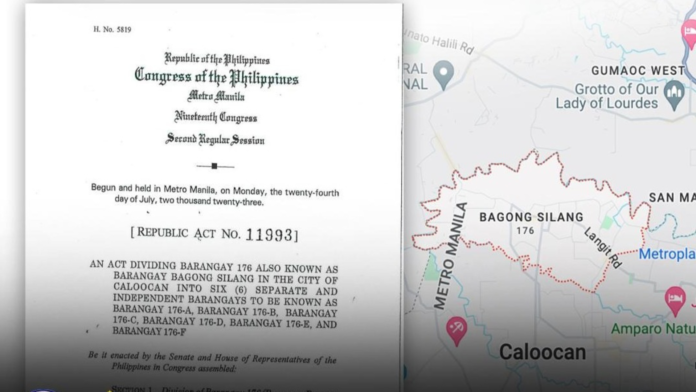President Ferdinand R. Marcos Jr. has signed into law Republic Act (RA) 11993, dividing Caloocan City’s Barangay 176, also known as Bagong Silang, into six independent villages.
Under RA 11993 signed by Marcos on April 3, Barangay Bagong Silang will be known as Barangay 176-A, Barangay 176-B, Barangay 176-C, Barangay 176-D, Barangay 176-E, and Barangay 176-F.
The territorial boundaries of each village will be the existing purok (phases).
RA 11993 directs the Commission on Elections (Comelec) to conduct and supervise the plebiscite within 90 days from the effectivity of the law.
The law also mandates the appointment of interim village officials, including the Punong Barangay (village chief) and seven chairpersons and members of the Sangguniang Kabataan (youth council) in each newly-created village to be designated by the mayor.
The appointed village officials will serve until their duly elected and qualified successors assume office, according to the new law.
RA 11993 states that incumbent village officials will continue to hold office until such time that the officials of the newly created villages have been duly appointed.
Public infrastructure and facilities existing at the time of the approval of RA 11993 will be transferred without cost or compensation and will be administered by the new villages.
All newly created villages will be entitled to the national allotment shares pursuant to Section 285 of RA 7160 or the Local Government Code of 1991.
RA 11993, passed by the House of Representatives on Nov. 21, 2022 and amended by the Senate on Dec. 11, 2023, takes effect 15 days after its publication in the Official Gazette or in a newspaper of general circulation.
A copy of the new law was made public on Friday.
Barangay Bagong Silang has a population of 261,729, accounting for 16 percent of Caloocan City’s population, based on the Philippine Statistics Authority census in 2020.
It was officially founded during the administration of Ferdinand E. Marcos Sr. in 1971, with the objective of ushering in a “new hope” for the many residents who had previously resided in slum areas across Metro Manila.
The village’s name, which translates to “newborn” in Filipino, was chosen to reflect the purpose for its establishment. (PNA)
Photo credit: Facebook/pcogovph


